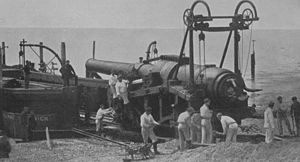The Elswick BL 16.25 inch naval gun was an early British superheavy rifled breech-loading naval gun, commonly known as the (Elswick) 110-ton gun or 111-ton gun.
| Ordnance BL 16.25 inch gun Mk I | |
|---|---|
 | |
| Type | Naval gun |
| Place of origin | United Kingdom |
| Service history | |
| In service | 1888 – 1909? |
| Used by | Royal Navy |
| Production history | |
| Manufacturer | Elswick Ordnance Company |
| No. built | 12 |
| Variants | no two guns were identical |
| Specifications | |
| Mass | 111 tons |
| Length | 43 ft 7 in; 13.3 m |
| Barrel length | 40 ft 8 in; 12.4 m bore (30 calibres) |
| Shell | 1,800 lb (820 kg) Armour-piercing, Common, or Shrapnel |
| Calibre | 16.25 in (413 mm) |
| Elevation | -5° – 13° |
| Rate of fire | about one round every three minutes |
| Muzzle velocity | 2,087 feet per second (636 m/s)[1] |
| Maximum firing range | 12,000 yards (11,000 m)[2] |
Service
editElswick had already supplied similar guns to Italy's Regia Marina and fitted in the Italian ironclad Andrea Doria of 1885 and the Royal Navy required parity for its Mediterranean Fleet. The adoption of this gun was influenced by the slow rate of production of the preferred new 13.5-inch (343 mm) guns: the Royal Navy had the option of delaying the completion of the new Admiral-class ironclads until sufficient 13.5-inch guns were available to equip them with four guns in two twin barbettes as planned; to use 12-inch (305 mm) guns, or to equip them with the new 16.25-inch (413 mm) guns.
The decision made was to install 16.25-inch guns in HMS Benbow in 1887 in single barbettes fore and aft, each gun substituting for two 13.5-inch guns. For the following HMS Victoria and HMS Sans Pareil the 16.25-inch guns were mounted in pairs in a single turret placed forward.
Weaknesses such as droop and cracking were discovered in the early design, and the many subsequent changes meant that none of the twelve guns built were identical, so the Mk I denomination was discontinued and the individual guns were referred to by their serial numbers. The great weight, low rate of fire and short life of less than 75 rounds meant that the guns were less than successful and were in fact never fired in action.
Ammunition
editSee also
editNotes
editReferences
edit- Text Book of Gunnery Archived 12 July 2012 at archive.today, 1902. London: Printed for His Majesty's Stationery Office, by Harrison and Sons, St. Martin's Lane
External links
edit- "Firing Trial of the 110½ ton B.L. Elswick Gun" in Scientific American supplement, No. 586, 26 March 1887. Transcribed by Project Gutenberg
- N J M Campbell, British Super-Heavy Guns
- Tony DiGiulian, British 16.25"/30 (41.2 cm) Mark I